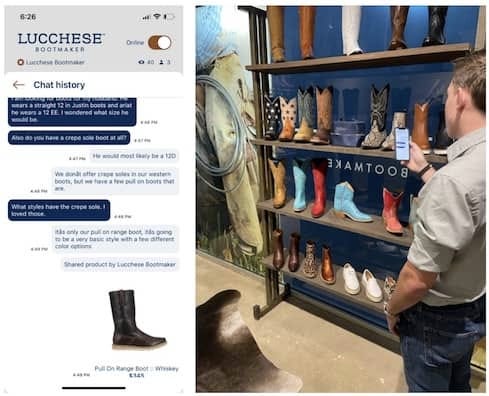Retailers Choosing Tech Upgrades Over Holiday Magic in 2021Retailers Choosing Tech Upgrades Over Holiday Magic in 2021
Retailers are busy improving their integration between online and physical sales channels this year, so don't count on them to deliver your holiday magic.

This year if you want holiday magic you're more likely to find it on Netflix than in your local department store. Holiday films often focus on the retail gift shopping experience with scenes inside department stores with joyful crowds, Santas and elves and glittery bright decorations. All this while snow falls outside against a winter sky. It’s magical.
And then there’s this year. Of course, this year is an improvement over last year when everyone was still planning to spend the holiday season alone, sheltering from the pandemic in a pre-vaccination era. This year with so many people vaccinated, there may be some holiday gatherings and gift exchanges on the calendar, but supply chain problems and a tight labor market has made this 2021 holiday season one of continuing challenges for retail companies.
Retailers used to try to create magic in the store to draw shoppers in and get them to spend during the holiday shopping season. Not so much anymore.
“Retailers have at least temporarily backed away from making the store a more entertaining experience,” says Dan Mitchell, director of the global retail practice at analytics software giant SAS. “In 2020 the script flipped. I would hardly call contactless retail innovative.”
Retailers are working on several initiatives in 2021 designed to improve upon the processes that they slapped together in a rush during 2020 to fit the needs of pandemic shopping patterns that had shifted in unexpected ways.
Omnichannel Fulfillment
After so much shopping moved online during the pandemic, whether it was gifts or groceries, retailers are working to create a better integration of these two worlds. For instance, omnichannel fulfillment has become a huge deal, says Mitchell. The goal is to eliminate inventory silos -- one for physical stores and another for online orders. Instead, organizations want to create a virtual inventory of all the stock that is in stores and in warehouses. From there, they want to fulfill orders with the inventory that will reach the customer in the shortest amount of time, whether that’s from a warehouse or a nearby store.
“The single most important thing is how to fill an omnichannel order efficiently,” Mitchell says.
Some of that importance comes from the fact that most every retailer is competing against Amazon, the giant online retailer that was able to use its analytics and supply chain dominance in the most recent year to beat everyone else in delivering what consumers wanted to buy by the next day.
Click-and-Collect
That may have caused what retail consulting firm RSR Research’s Managing Director Brian Kilcourse calls a huge boom in click-and-collect. That’s where consumers order their groceries or lighting fixtures or new game consoles online at the brand’s website ahead of time for a later in-store pick up. This is a business that boomed during 2020 and after, as shoppers avoided stores during the pandemic, and sometimes were even forced to stop shopping in person due to lockdowns.
The Online Sales Experience
Other retailers focused on creating a more inviting sales experience for their online customers.
For instance, high-end luxury cowboy boots and leather goods maker Lucchese added to its ecommerce sales site the ability to not only do a text chat with customers, but also to initiate a video call with one of the physical store’s sales representatives.
“People’s preference to buy cowboy boots is usually in person,” says Lucchese marketing pro David Berger. “People want to feel and touch and try on the boots and get the product knowledge firsthand. Boots are unique. They are not like trying on sneakers or dress shoes. There are different styles and foot types, and that can make it challenging to sell them online.”

Image provided courtesy of Lucchese
Lucchese launched the service before the pandemic started, but the pandemic was a catalyst for its growth. Berger said that the addition allowed Lucchese stores to continue to operate, even during lockdowns.
Sales representatives are able to chat with customers about style preferences, sizes, and other product-specific information. It’s the kind of information customers want when they are investing in a high-end item.
Most questions are about sizing, Berger says, and when sales reps can offer customers guidance on sizing, that reduces returns, an important KPI in retail.
Lucchese added this feature to its web site by using Immerss software, which is currently available to online retailers on the Shopify platform. Immerss CEO Arthur Veytsman says that luxury brands have struggled with how to service customers virtually during the pandemic. Chat has traditionally been about providing customer service, not about sales. Flipping that idea is where Veytsman got the idea for Immerss.
“That was the big aha moment for me,” Veytsman says. “Customers are always left on their own on the website to do their shopping.” They aren’t guided and offered personal service the way they have been when they shop in person at some high-end retail stores. Veytsman created Immerss to help retailers close that gap.
Immerss offers two services to retail customers. One is the video one-to-one connection that facilitates what retailers call “clientelling” -- that kind of personal service and guidance offered to customers. The second is a one-to-many type of broadcast capability that enables brands to do video QVC-like sales shows and trunk shows. The brand Dress Barn is one of the retailers using the latter service.
Holiday Shopping 2021
While you may see holiday decorations and other enticements in physical stores this year, it hasn’t been the primary focus for many retailers in the 2021 holiday shopping season. Retailers just aren’t working to differentiate with the same kind of in-store magic that they have in past years. Right now they are working to improve on the systems that they put into place so quickly to respond to the pandemic and shifting consumer buying patterns. But don’t count out that magic for the future, says Mitchell.
“Retailers will get back to examining the store and making it an interesting experience,” he says.
What to Read Next:
Why a Low-Code Development Recipe Worked for Pampered Chef
Data Analytics Can Fix the Supply Chain. Eventually
About the Author
You May Also Like






